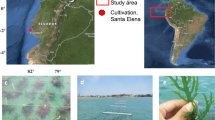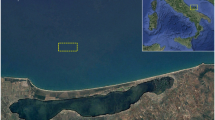Abstract
Our field experiments showed that the cultivation of pearl mussels formed a new biocoene composed of filamentous algae, protozoa, porifera and coelenterate. It effectively reduced nitrogen, phosphorus, chemical oxygen demand and biochemical oxygen demand in the water by 67.3%, 73.2%, 38.1% and 15.5%, respectively, during May to September 1998 when the water eutrophication was developing. This could control water eutrophication and produce pearls, shellfish meat and shells. This is an economical and effective way to control water eutrophication by using the ultra strong filtering capability of freshwater pearl mussels.
Similar content being viewed by others
References
Chen, J. R., 1996. Water Chemistry (the experiment guide). China's Agricultural Press, Beijing, China, p. 19–30. (in Chinese)
Cai, Y. Y., Y. Zhang and R. F. Wei, 1982. Shellfishes, Shanghai Science Tech. Press, Shanghai, China, 121–130 p. (in Chinese)
Forsberg, C., 1998. Which policies can stop large scale eutrophication?J. Water Science and Technology 37(3): 193–200.
Fang, J. G., H. L. Sun, S. H. Kuang, X. M. Liang, X. D. Niu, Z. H. Liu and H. Li, 1999. The research on mud strains water rate and eats the rate of blood clam's larva.J. Oceanol. Limnol. 3: 167–171.
Hildreth, D. J., 1976. The influence of eater flow rate on pumping activity inMytilus edulis using a refined direct measurement apparatus.J. Mar. Biol. Assoc. UK 56: 311–319.
Jin, X. C. and Q. Y. Tu, 1990. Investigate the Standard in eutrophication of Lake, China Environmental Science Press, Beijing, China, p. 39–47. (in Chinese)
Koelmans, A., A. van der Heijde, L. M. Knijff and R. H. Aalderink, 2001. Integrated modeling of eutrophication and organic contaminant fate & effects in aquatic ecosystems.J. Water Research 35(15): 3517–3536.
Metcalfe, S. E., R. G. Derwent, J. D. Whyatt and H. Dyke, 1998. Nitrogen deposition and strategies for the control of acidification and eutrophication across Great Britain.Water, Air and Soil Pollution 107(1–4): 121–145.
Liu, W. X., 1997. The application studies on control agricultures source pollution by the artificial wet ground.J. Environmental Scientific Research 10 (4): 15–19. (in Chinese)
Shao, L. G., Y. J. You, H. F. Tao, M. X. Zeng and D. Weng, 1999. The Effects of control and removal of phosphorus on the process of controlling the eutrophication of water body.J. Environmental and Development 14 (2): 19–20. (in Chinese)
Shi, Y., X. Q. Zhang, C. Y. Fu, F. Gao and R. X. Xu, 1998. The preliminary discussions to to epurating eutrophication lake by zooplankton.J. Northeastern Conservancy and Electricity of Water 164 (3): 31–33. (in Chinese)
Sun, H. L., J. G. Fang, S. H. Kuang and F. Li, 1995. The strains the survey of water rate ofChlamys farreri in the natural water environment of simulation.J. Chinese Aquatic Science 2(4): 16–21. (in Chinese)
Wang, G. X., X. Y. Cheng and P. M. Pu, 1999. The impact on alga stock of lake of eutrophication by severol control measure artificially.J. Environmental Science 20(2): 71–74. (in Chinese)
Wang, Z. H., T. J. Jiang, S. Qi, Y. M. Lu and Y. Z. Qi, 1999. Study on nitrogenand phosphorus removal capacity ofHydrodictyon reticulatum in eutrophication fresh water samples.J. Actascientiae Circumstantial 4: 448–452. (in Chinese)
Yang, H. S., D. S. Li and S. L. Dong, 1998. Preliminary study on polyculture of filter-feeding fish with mollusc in fertilized seawater ponds.Journal of Ocean University of Qingdao 28(2): 217–222. (in Chinese)
Zacek, L. A., 1998. Technological and hygienic consequences of reservoirs eutrophication in the Czech Republic Sladeckova.J. Water Science and Technology 37(2): 195–202.
Author information
Authors and Affiliations
Rights and permissions
About this article
Cite this article
Genfang, Z., Minzhong, D. & Aiping, F. The effects of co-cultivation of pearl mussels and fishes on water pollution control in middle or small sized water. Chin. J. Ocean. Limnol. 22, 425–430 (2004). https://doi.org/10.1007/BF02843640
Received:
Accepted:
Issue Date:
DOI: https://doi.org/10.1007/BF02843640




